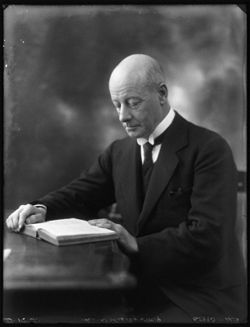Wolseley Haig
Sir Thomas Wolseley Haig KCIE CSI CMG CBE (7 August 1865[1] – 28 April 1938[2]) was a civil servant in British India, then Professor at Trinity College, Dublin, and later a Scottish herald.
Sir Wolsley Haig | |
|---|---|
 | |
| Albany Herald | |
| In office 1927–1935 | |
| Monarch | George V |
| Preceded by | Sir George Swinton |
| Succeeded by | Sir Thomas Innes |
| Workplaces | Trinity College, Dublin School of Oriental and African Studies |
| Languages | Persian, Arabic, Hindustani |
| Personal details | |
| Alma mater | Wellington College, Berkshire |
Early lifeEdit
Haig was the son of Major Robert Wolseley Haig RA, FRS, (1830–72) the military astronomer. He was descended from the Haigs of Bonnington, branch of the Border house of Haig of Bemersyde. He is thus related to the first Lord Haig. He was educated at Wellington College, and then Sandhurst.[1]
Army careerEdit
Haig joined the Seaforth Highlanders in 1884 and was transferred to the Indian Army in 1887 where he served in Upper Burma (1887–89) fighting "dacoits" (bandits).[1] He won a medal and clasp for his service.[3] He was promoted to Captain on 6 February 1895, and to Major on 6 February 1902.[4]
Indian civil serviceEdit
Haig entered the Berar Commission in 1892 and became Assistant Commissioner, then Deputy Commissioner, Inspector-General of Police, Jails, Stamps, Registration, and Excise, and Civil and Sessions Judge. He was officiating Secretary to the Board of Examiners, Fort William, 1897 and 1898–99. He entered the Political Department in 1901 as First Assistant to the Resident at Hyderabad, a post that gave him day to day control of Berar.[1]
Haig became Assistant Secretary to the Government of India, Foreign Department, in 1907, then Political Agent in Alwar, 1907–08. Following the assassination of Sir Curzon Wyllie in London by Madan Lal Dhingra in 1909, Haig was appointed officiating Political ADC to the Secretary of State for India 1909–10 (Lord Morley).
Haig's final years abroad were spent mostly in Persia. He was the British Consul at Kerman in 1910, became First Assistant to the Agent to the Governor-General in Baluchistan in 1912 and quickly moved on to become Consul-General and Agent to the Government of India, Khurasan, Persia in 1914–16. He held the same post at Ispahan 1916 and Tehran 1919. He retired in 1920.[1]
Academic careerEdit
Soon after Haig returned to Europe, he was appointed Professor of Arabic, Persian and Hindustani at Trinity College, Dublin. Later he was lecturer in Persian at the School of Oriental Studies, University of London. Haig was known for his meticulous attention to detail and the careful planning which went into his work. Some reviewers said that he tended to go too far and produce an overly-detailed end result, but his writings appeared in the Journal of the Royal Asiatic Society, and other learned societies, and he was assigned the third and fourth volumes of The Cambridge History of India. Unfortunately, he was only able to fully complete the third volume before illness set in and the fourth had to be completed by Richard Burn to Haig's plan. It was published in 1937, the year before Haig's death.[1]
Haig made two important translations into English of Badaoni's Tarikh-i-Bada'uni (history), a source for the reign of Emperor Akbar's, and the Burhan-i-Massir of Tabatabai, an important source for the Nizam Shahi dynasty of Ahmadnagar.[1]
HeraldEdit
Haig was appointed March Pursuivant of Arms in Scotland in 1923 and was Albany Herald 1927–35.[3]
Personal lifeEdit
Haig married Beatrice, older sister of Michael Lloyd Ferrar, ICS, in 1892. Beatrice died in 1927. They had one son (Robert Wolseley) who joined the Imperial Bank of Iran, and two daughters (Margaret Wolseley and Helen Ferrar).[1]
DeathEdit
Haig died at home, in Kensington, London, on 28 April 1938 after a long illness.[1]
Selected publicationsEdit
- Books
- Hints on the study of Urdu, for the use of candidates for the lower and higher standard examinations in that language. Pioneer Press, Allahabad, 1898.
- Historical landmarks of the Deccan. Pioneer Press, Allahabad, 1907.
- The history of the Nizam Shahi kings of Ahmadnagar. British India Press/Education Society's Press, Bombay, 1923. (Reprinted from The Indian Antiquary, April 1920 – November 1923.)
- The Cambridge history of India Vol. III Turks and Afghans. University Press, Cambridge, 1928. Edited by Wolseley Haig.
- Persian grammar. Linguaphone Institute, London, c. 1930.
- Persian. Linguaphone Institute, London, 1933. (With Darab Khan, Mojtaba Minovi and Ghulām Ḣusain) (third edition) (Linguaphone Oriental language Courses)
- The Cambridge shorter history of India. University Press, Cambridge, 1934. Editor H.H. Dodwell. (contributor)
- The Cambridge history of India Vol. IV The Mughul period. University Press, Cambridge, 1937. Planned by Wolseley Haig, edited by Richard Burn.
- Other works
- Various entries in The Encyclopaedia of Islam.
- Contributions to the Persian Bible published in London by B. & F.B.S., 1928.
ReferencesEdit
- ↑ 1.0 1.1 1.2 1.3 1.4 1.5 1.6 1.7 1.8 "Obituary: Sir Wolseley Haig, Soldier Administrator, Orientalist" in The Times, 30 April 1938, p. 14.
- ↑ "Deaths" in The Times, 30 April 1938, p. 1.
- ↑ 3.0 3.1 "HAIG, Lt-Col Sir (Thomas) Wolseley" in Who Was Who, A & C Black, Oxford University Press, 2014, online edition. Retrieved 28 May 2014.
- ↑ "No. 27428". The London Gazette. 25 April 1902. p. 2794.